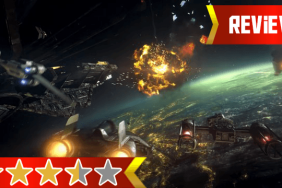Save the Kobayashi Maru!
Most Star Trek computer games have been pretty bad. It seems
that most of them try to get by on their name alone and leave out
anything of quality. So it was with some trepidation that I
installed Starfleet Academy. For those non-trekkies out there,
Starfleet Academy is the Federation training facility where
cadets are prepared to become officers in Starfleet, which is
like the military.
Starfleet Academy
is part simulation, part adventure game. As is customary with space simulator
games, the player plays through a set of missions interspersed with cinematic
segments and some character interaction. You interact with your fellow cadets
by watching video sequences and choosing your response from a brief list. Unfortunately,
the response you choose usually has little effect on the outcome of the scene.
Most of your time will be spent in the Starship Simulator. The
Starship Simulator places you on the bridge of a Constitution-
Class starship in the role of the captain. You have control over
nearly every aspect of starship operations, including weapons
settings, navigation, energy allocation, damage control,
transporters, and communications. From your captain’s chair you
control your starship’s every move. Although this gives you a
lot of control, it also means that instead of ordering your ship
to a specific heading, you manually steer it there either via the
keyboard or by (wince!), a joystick. It might just be me, but if
a joystick isn’t good enough for Kirk, it’s not good enough for
me.
Tea, Earl Grey, hot.
The simulator’s pace is a little slower than that which players of TIE-Fighter
and Wing Commander will be used to. The simulator’s pace is still faster
than the combat scenes of episodes or movies, so players wanting a slow, Picard-style
battle should look elsewhere. The pace of battle was probably a compromise between
the fast pace of action games, and the slow pace found on the show. As a nice
bonus, included in the set of missions is the famed ‘Kobayashi Maru’ scenario,
as well as a way to use the same trick Kirk used to beat it.
 Graphically, Starfleet
Graphically, Starfleet
Academy is near the head of the pack. It uses texture mapping, light sourcing,
Gouraud shading, and transparent effects to create a very convincing simulation.
All these frills come with a price, however, because the recommended system
is a Pentium 150 with a 3d-accelerator card. Starfleet Academy features an original
storyline written by D.C. Fontana, writer of many original series episodes.
The story is delivered by copious video sequences spread out across 5 CDs.
Physics, Shmysics…
Starfleet is about as realistic as the Star Trek franchise, which
isn’t saying much. Your ship stops as soon as you cut thrust,
which is as shown in the series, but is not very realistic. Also,
gravity is nonexistent except when very close to a planet. The
game looks and sounds very much like Star Trek in the movies 2-6.
Shields have a very nice shimmer effect when weapons hit them,
and the sounds are identical to those familiar to trekkies.
My main problems with Starfleet Academy are its pace of play, which
is quite different from that found in episodes of movies, its shamefully large
hard disk footprint, and a number of minor bugs and brief freeze-ups which I
hope will be corrected in the upcoming patch. However, Starfleet is the
best simulation ever of commanding a Federation Starship. It may not appeal
to Star Trek purists by taking a more action-oriented approach to the simulation,
but it will definitely appeal to space simulation fans and to the majority of
trekkies.
-
- Well detailed starship simulator
-
- Faster pace than in episodes or movies
-
- Beautiful shield effects
-
- Several minor bugs
-
- Hard disk hog











